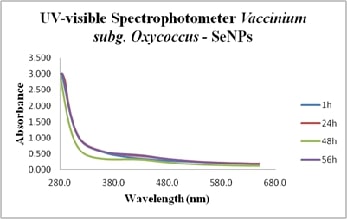Green Synthesis of Selenium Nanoparticles using Vaccinium Subg. Oxycoccus for Antioxidant, Anti-Inflammatory, and Cytotoxic Effect

Abstract:
This
study elucidates the synthesis and multifaceted applications of selenium
nanoparticles (SeNPs) utilizing Vaccinium subg. Oxycoccus extract as a green
and sustainable methodology. The UV-visible spectroscopy analysis demonstrated
the successful synthesis of SeNPs, characterized by a distinct absorption peak
at 380 nm. The antioxidant activities of Vaccinium subg. Oxycoccus-mediated
SeNPs were systematically evaluated through three assays. The DPPH assay
revealed concentration-dependent radical scavenging activities, surpassing the
standard (ascorbic acid) at higher concentrations. Additionally, the Hydrogen
Peroxide assay showcased commendable antioxidant properties, while the FRAP
assay indicated a concentration-dependent capacity to reduce ferric ions,
suggesting potential in counteracting oxidative stress. Inhibition of protein
denaturation was examined using the BSA assay, revealing a significant
inhibitory effect of Vaccinium subg. Oxycoccus-mediated SeNPs that increased
with concentration. Denaturation studies, employing the Egg Albumin
Denaturation Assay, displayed a concentration-dependent rise in denaturation
percentages, either matching or exceeding the standard's anti-inflammatory
activity. The Membrane Stabilization Assay illustrated the
concentration-dependent enhancement of membrane stability by SeNPs, exhibiting
efficacy comparable to or exceeding the standard. Cytotoxicity assessment
through the Brine Shrimp lethality assay demonstrated a concentration-dependent
decline in brine shrimp nauplii viability, suggesting a potential cytotoxic
impact of Vaccinium subg. Oxycoccus-mediated SeNPs. These findings collectively
underscore the diverse applications of SeNPs synthesized with Vaccinium subg.
Oxycoccus extract, ranging from antioxidant activities and membrane
stabilization to potential cytotoxic effects, lays the groundwork for their
versatile application in biological and medicinal contexts.
References:
[1].
Haleem, A., Javaid, M.,
Singh, R. P., Rab, S., Suman, R., 2023, Applications of nanotechnology in the medical
field: a brief review. Glob Health J.;7: 70–77. doi:10.1016/j.glohj.2023.02.008
[2].
Pasika, S. R., Bulusu, R.,
Rao, B. V. K., Kommineni, N., Bolla, P. K., Kala, S. G., et al., 2023,
Nanotechnology for Biomedical Applications. Nanomaterials. Singapore:
Springer Nature Singapore;. 297–327. doi:10.1007/978-981-19-7963-7_11
[3].
Rezić, I., 2022, Nanoparticles
for biomedical application and their synthesis. Polymers (Basel).;14 (9)
4, 961. doi:10.3390/polym14224961
[4].
Chen, J., Li, L., Song, K.,
Wang, Z., 2022, Application of different nanomaterials in biomedical field. Highlights
in Science, Engineering and Technology.;14: 57–64.
doi:10.54097/hset.v14i.1593
[5].
Tharani, M., Rajeshkumar,
S., Al-Ghanim, K. A., Nicoletti, M., Sachivkina, N., Govindarajan M., 2023, Terminalia
chebula-Assisted Silver Nanoparticles: Biological Potential, Synthesis,
Characterization, and Ecotoxicity. Biomedicines, 11.
doi:10.3390/biomedicines11051472
[6].
Xie, B., Zeng, D., Yang,
M., Tang, Z., He, L., Chen, T., 2023, 1Translational selenium nanoparticles to
attenuate allergic dermatitis through Nrf2-Keap1-driven activation of
selenoproteins. ACS Nano. 7: 14053–14068. doi:10.1021/acsnano.3c04344
[7].
Devi, M. S., Srinivasan,
S., Muthuvel, A., 2023, Selenium nanomaterial is a promising nanotechnology for
biomedical and environmental remediation: A detailed review. Biocatal Agric
Biotechnol. 51: 102766. doi:10.1016/j.bcab.2023.102766.
[8].
Kurup, M., Kumar, M.,
Ramanathan, S., Chandra, M., 2023, The biogenetic synthesis of metallic nanoparticles
and the role they play in anti-inflammatory drug treatment. Curr Drug Discov
Technol. 20. doi:10.2174/1570163820666230718123544
[9].
Li, Y., Zhu, S., Luo, J.,
Tong, Y., Zheng, Y., Ji, L., et al., 2023, The Protective Effect of Selenium
Nanoparticles in Osteoarthritis: In vitro and in vivo Studies. Drug Des
Devel Ther. 17: 1515–1529. doi:10.2147/dddt.s407122
[10]. Arafa, F. M., Mogahed, N. M. F. H., Eltarahony, M. M., Diab,
R. G., 2023, Biogenic selenium nanoparticles: trace element with promising
anti-toxoplasma effect. Pathog Glob Health. 117: 639–654.
doi:10.1080/20477724.2023.2186079
[11]. Santhoshkumar, J., Kumar, S. V., Rajeshkumar, S., 2017, Synthesis
of zinc oxide nanoparticles using plant leaf extract against urinary tract
infection pathogen. Resour-Effic Technol. 3: 459–465.
doi:10.1016/j.reffit.2017.05.001
[12]. Menon, S., Agarwal, H., Rajeshkumar, S., Jacquline Rosy, P.,
Shanmugam, V. K., 2020, Investigating the antimicrobial activities of the
biosynthesized selenium nanoparticles and its statistical analysis. Bionanoscience.
10: 122–135. doi:10.1007/s12668-019-00710-3
[13]. Rajeshkumar, S., Tharani, M., Jeevitha, M., Santhoshkumar, J.,
2019, Anticariogenic activity of fresh aloe Vera gel mediated copper oxide
nanoparticles. Indian J Public Health Res Dev. 10: 3664.
doi:10.5958/0976-5506.2019.04158.5
[14]. Zhidkin, R., Zhurbenko, P., Bogomaz, O., Gorodilova, E.,
Katsapov, I., Antropov, D., et al., 2023, Biodiversity of rolB/C-like natural
transgene in the genus Vaccinium L. and its application for phylogenetic
studies. Int J Mol Sci. 24. doi:10.3390/ijms24086932
[15]. A. Waikar, B., C. Mandave, P., Berries: A new paradigm for
nutraceuticals., 2023, Edible Berries - New Insights. IntechOpen;
doi:10.5772/intechopen.1002226
[16]. Martău, G. A., Bernadette-Emőke, T., Odocheanu, R., Soporan,
D. A., Bochiș, M., Simon, E., et al. 2023, Vaccinium species (Ericaceae):
Phytochemistry and biological properties of medicinal plants. Molecules. 28.
doi:10.3390/molecules28041533
[17]. Nurzyńska-Wierdak, R., 2023, Phenolic compounds from new
natural sources-plant genotype and ontogenetic variation. Molecules. 28.
doi:10.3390/molecules28041731
[18]. Priyaa, N. P., Rajeshkumar, S., Lakshmi, T., Roy, A., 2020, Antibacterial
Properties of Lodhra Bark (Symphlocus racemosa) Mediated Silver
Nanoparticles Against Oral Pathogens. Plant Cell Biotechnology And Molecular
Biology. 1–7.
[19]. Sharma, S. K., Singh, A. P., 2012, In vitro antioxidant and
free radical scavenging activity of Nardostachys jatamansi DC. J
Acupunct Meridian Stud. 5: 112–118. doi:10.1016/j.jams.2012.03.002
[20]. Bhatti, M. Z., Ali, A., Ahmad, A., Saeed, A., Malik, S. A., 2015,
Antioxidant and phytochemical analysis of Ranunculus arvensis L.
extracts. BMC Res Notes.;8: 279. doi:10.1186/s13104-015-1228-3
[21]. Long, Q., Cui, L-K., He, S-B., Sun, J., Chen, Q-Z., Bao, H-D.,
et al., 2023, Preparation, characteristics and cytotoxicity of green
synthesized selenium nanoparticles using Paenibacillus motobuensis
LY5201 isolated from the local specialty food of longevity area. Sci Rep.
13. doi:10.1038/s41598-022-26396-4
[22]. Vu, T. T., Nguyen, P. T. M., Pham, N. H., Le, T. H., Nguyen,
T. H., Do, D. T., et al., 2022, Green synthesis of selenium nanoparticles using
Cleistocalyx operculatus leaf extract and their acute oral toxicity study. J
Compos Sci. 6: 307. doi:10.3390/jcs6100307

